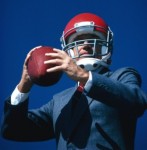How Is Law School Like the NFL Draft?

(Photos.com)
Here’s a smart take by Jonathan Tjarks on the current state of law schools — a rather depressing look at how the odds are similarly stacked against law-school grads and college football players. After opening with a reference to Sudhir Venkatesh‘s study of the economics of crack from Freakonomics, Tjarks’s piece boils down to the following analysis:
Admittance into a top-14 law school, like a scholarship from a top-10 college football program, is the culmination of a lifetime of striving. Of the over 100,000 high school seniors who play football, fewer than 3,000 sign Division I letters of intent. Similarly, the top 25% in Harvard Law’s 2009 class had an average GPA of 3.95 and a LSAT score of 175, which puts them in the 99th percentile of the over 100,000 test takers each year.
Yet, despite overcoming nearly impossible odds, each group still has the toughest test of their lives ahead of them — each other. NFL teams rarely draft players not at the top of the depth chart, even at powerhouses like Texas or Oklahoma. And even at Harvard or Columbia Law, “Big Law” firms — those with the coveted $160,000 starting salaries — don’t reach too far below the median class rank when selecting first-year associate.
As you go down the ranks, the odds only decrease. NFL players from non-BCS conferences were usually top-tier starters in college, while top-50 law schools typically send only 10-25% of each class to “Big Law”. And just as there are always a few DII and DIII players in the draft each year, students from tier 2 and tier 3 law schools occasionally beat out graduates of elite schools for jobs. But “small school” success stories are the best of the best — collegiate All-Americans, the top 1% of their class in law review.
Tjarks also compares the long term hidden costs of each profession:
The newest research on concussions indicates that the gravest threats to players are not the highlight-reel hits, but the trauma of endless low-impact collisions over years of practice. Football players, especially linemen, usually put on 30-40 pounds of muscle in college, locking themselves into eating habits that will become increasingly unhealthy when they no longer burn thousands of calories a day in practice.
Law students who miss out on “Big Law” in 2L OCI are often left with over $100,000 in non-dischargeable student loan debt that can take most of their professional lives to pay off. The high starting salaries of first-year New York City associates hide the bimodal distribution of law incomes — most lawyers earn modest middle-class salaries and have little opportunity to transfer into the “Big Law” salary structure, not when there are thousands of new students clamoring for spots coming in behind them each year.
At least the job market for NFL draftees has remained intact, pending of course the resolution of the NFL lockout. The same can’t be said for law school grads. According to a Northwestern Law study, some 15,000 jobs have been eliminated from the nation’s biggest law firms since 2008. Which was roughly the same number of newspaper jobs lost in 2009, according to another Northwestern study.

Comments